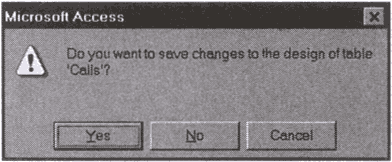Saving a Database
You need to save your work so that you don't lose anything you've typed after you turn off the computer. When you created the database, you saved it by naming it. When you enter each record, Access automatically saves your work. (You'll learn to enter records in Lesson 10.) There's no need to save your work until you're ready to close your database.
When you change the structure of a table, form, or other object, however, Access will not let you close that object or close the database without confirming whether or not you want to save your changes. You'll see a dialog box like the one in Figure 6.1; just click Yes to save your changes.
Figure 6.1. When you make changes to an object's structure, Access asks whether it should save your changes.

Notice that the Save and Save As commands on the File menu aren't even available most of the time; they're grayed out. When you have a particular object highlighted in the Database window, such as a table, the Save As/Export command is available. You can use this command to save your table in a different format that another program (such as Excel) can read.
Using Tables in Other Programs
Another way to copy a table to another application, or to another database, is with the Copy and Paste commands. Highlight the table in the Database window and select Edit, Copy. Then open a different database or application and select Edit, Paste. A dialog box opens, giving you the options of pasting the table structure only or the structure plus its data. You can also choose to append the data to existing tables, if the fields match up.
